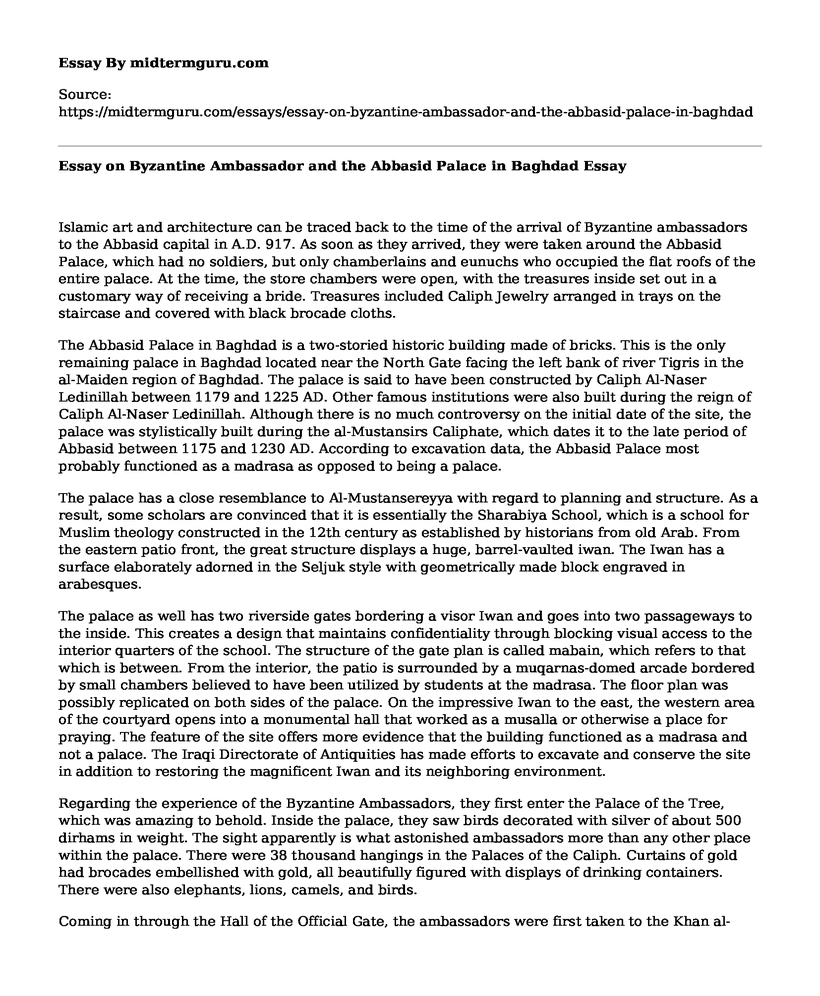Islamic art and architecture can be traced back to the time of the arrival of Byzantine ambassadors to the Abbasid capital in A.D. 917. As soon as they arrived, they were taken around the Abbasid Palace, which had no soldiers, but only chamberlains and eunuchs who occupied the flat roofs of the entire palace. At the time, the store chambers were open, with the treasures inside set out in a customary way of receiving a bride. Treasures included Caliph Jewelry arranged in trays on the staircase and covered with black brocade cloths.
The Abbasid Palace in Baghdad is a two-storied historic building made of bricks. This is the only remaining palace in Baghdad located near the North Gate facing the left bank of river Tigris in the al-Maiden region of Baghdad. The palace is said to have been constructed by Caliph Al-Naser Ledinillah between 1179 and 1225 AD. Other famous institutions were also built during the reign of Caliph Al-Naser Ledinillah. Although there is no much controversy on the initial date of the site, the palace was stylistically built during the al-Mustansirs Caliphate, which dates it to the late period of Abbasid between 1175 and 1230 AD. According to excavation data, the Abbasid Palace most probably functioned as a madrasa as opposed to being a palace.
The palace has a close resemblance to Al-Mustansereyya with regard to planning and structure. As a result, some scholars are convinced that it is essentially the Sharabiya School, which is a school for Muslim theology constructed in the 12th century as established by historians from old Arab. From the eastern patio front, the great structure displays a huge, barrel-vaulted iwan. The Iwan has a surface elaborately adorned in the Seljuk style with geometrically made block engraved in arabesques.
The palace as well has two riverside gates bordering a visor Iwan and goes into two passageways to the inside. This creates a design that maintains confidentiality through blocking visual access to the interior quarters of the school. The structure of the gate plan is called mabain, which refers to that which is between. From the interior, the patio is surrounded by a muqarnas-domed arcade bordered by small chambers believed to have been utilized by students at the madrasa. The floor plan was possibly replicated on both sides of the palace. On the impressive Iwan to the east, the western area of the courtyard opens into a monumental hall that worked as a musalla or otherwise a place for praying. The feature of the site offers more evidence that the building functioned as a madrasa and not a palace. The Iraqi Directorate of Antiquities has made efforts to excavate and conserve the site in addition to restoring the magnificent Iwan and its neighboring environment.
Regarding the experience of the Byzantine Ambassadors, they first enter the Palace of the Tree, which was amazing to behold. Inside the palace, they saw birds decorated with silver of about 500 dirhams in weight. The sight apparently is what astonished ambassadors more than any other place within the palace. There were 38 thousand hangings in the Palaces of the Caliph. Curtains of gold had brocades embellished with gold, all beautifully figured with displays of drinking containers. There were also elephants, lions, camels, and birds.
Coming in through the Hall of the Official Gate, the ambassadors were first taken to the Khan al-Khayl. It was a palace mainly made of peristyle court with marble columns. There were 500 horses on the right side of the building, each of them caparisoned with a gold or silver saddle. However, the 500 horses on the left-hand side had brocade saddlecloths in addition to long head-covers. The ambassadors then came to the New Kiosk, a palace in the middle of two gardens. At the center of this palace was a simulated pond of white lead, which appears more radiant than polished silver. After the Palace of the Tree, the ambassadors entered the Palace of paradise. This area had carpets and furniture in large numbers that cannot be enumerated and thousands of gilded breastplates hanging around the hall. The Greek convoy continued across a corridor that was 300 cubits long. Thousands of other bits of arms, helmets, buckler, casques, and coats hang on either side of the corridor. Ambassadors had the opportunity to meet two thousand eunuchs positioned strategically along the corridor.
After visiting about 23 different palaces, they came to the Court of the Ninety. In this region, there were pages of the Privy Chamber, which looked spectacular since they were full-armed and magnificently dressed. These people carried swords in their hands as well as small battle-axes and maces. The convoy then went past black slaves comprising of the deputy chamberlains, soldiers, footmen, and chieftains sons. The different palaces visited by the Byzantine Ambassadors gave an impressive view. These palaces were a true presentation of the Islamic art and architecture defining Baghdad from a historical perspective.
Cite this page
Essay on Byzantine Ambassador and the Abbasid Palace in Baghdad. (2021, May 24). Retrieved from https://midtermguru.com/essays/essay-on-byzantine-ambassador-and-the-abbasid-palace-in-baghdad
If you are the original author of this essay and no longer wish to have it published on the midtermguru.com website, please click below to request its removal:
- Article Review: My First Conk by Malcolm X
- Essay on Sure Thing by David Ives, Shawn Amaros Version
- Should Violence Be Censored From Media For Underage Children? - Essay Sample
- Essay Sample on A Visit to the War Museum
- Thierry Mugler Fashion Exhibition at Montreal Museum of Fine Arts - Essay Sample
- Exploring the Fascinating World of Social Media: A Journey of Discovery - Essay Sample
- Hidden Figures Movie Analysis Essay







